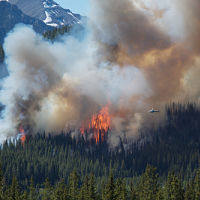
 |
|

|
Thunderstorms and Lightening Lightning's risk to individuals and property is increased because of its unpredictability, which emphasizes the importance of preparedness. It often strikes outside of heavy rain and may occur as far as 10 miles away from any rainfall. Most lightning deaths and injuries occur when people are caught outdoors in the summer months during the afternoon and evening. Step 1: Get a Kit Get an Emergency Supply Kit, which includes items like non-perishable food, water, a battery-powered or hand-crank radio, extra flashlights and batteries. Step 2: Make a Plan Prepare Your Family  Make a Family Emergency Plan. Make a Family Emergency Plan.  Inform babysitters and caregivers of your plan. Inform babysitters and caregivers of your plan.  Take a Community Emergency Response Team (CERT) class from your local Citizen Corps chapter. Keep your training current. Take a Community Emergency Response Team (CERT) class from your local Citizen Corps chapter. Keep your training current.  Remember the 30/30 Lightning Safety Rule: Go indoors if, after seeing lightning, you cannot count to 30 before hearing thunder. Stay indoors for 30 minutes after hearing the last clap of thunder. Remember the 30/30 Lightning Safety Rule: Go indoors if, after seeing lightning, you cannot count to 30 before hearing thunder. Stay indoors for 30 minutes after hearing the last clap of thunder. Step 3: Be Informed Familiarize yourself with the terms that are used to identify a thunderstorm hazard  A thunderstorm watch means there is a possibility of a thunderstorm in your area. A thunderstorm watch means there is a possibility of a thunderstorm in your area.  A thunderstorm warning means a thunderstorm is occurring or will likely occur soon. If you are advised to take shelter, do so immediately. A thunderstorm warning means a thunderstorm is occurring or will likely occur soon. If you are advised to take shelter, do so immediately. Prepare Your Home  Remove dead or rotting trees and branches that could fall and cause injury or damage during a severe thunderstorm. Remove dead or rotting trees and branches that could fall and cause injury or damage during a severe thunderstorm.  Secure outdoor objects that could blow away or cause damage. Secure outdoor objects that could blow away or cause damage.  Shutter windows and secure outside doors. If shutters are not available, close window blinds, shades or curtains. Shutter windows and secure outside doors. If shutters are not available, close window blinds, shades or curtains.  Find out how to keep food safe during and after and emergency by visiting: http://www.foodsafety.gov/keep/emergency/index.html Find out how to keep food safe during and after and emergency by visiting: http://www.foodsafety.gov/keep/emergency/index.html Listen to Local Officials Learn about the emergency plans that have been established in your area by your state and local government. In any emergency, always listen to the instructions given by local emergency management officials. For further information on how to plan and prepare for thunderstorms and lightening as well as what to do during and after a thunderstorm, visit: Federal Emergency Management Agency, NOAA Watch, or American Red Cross. |
|
|||||||||||||||||||||||
| Mary Greeley Medical Center, 1111 Duff Avenue, Ames, Iowa 50010, (515) 239-2011 | |||||||||||||||||||||||||
| ©2025 FastHealth Corporation Terms Privacy | US Patent Numbers 7,720,998 B2, 7,836,207 |